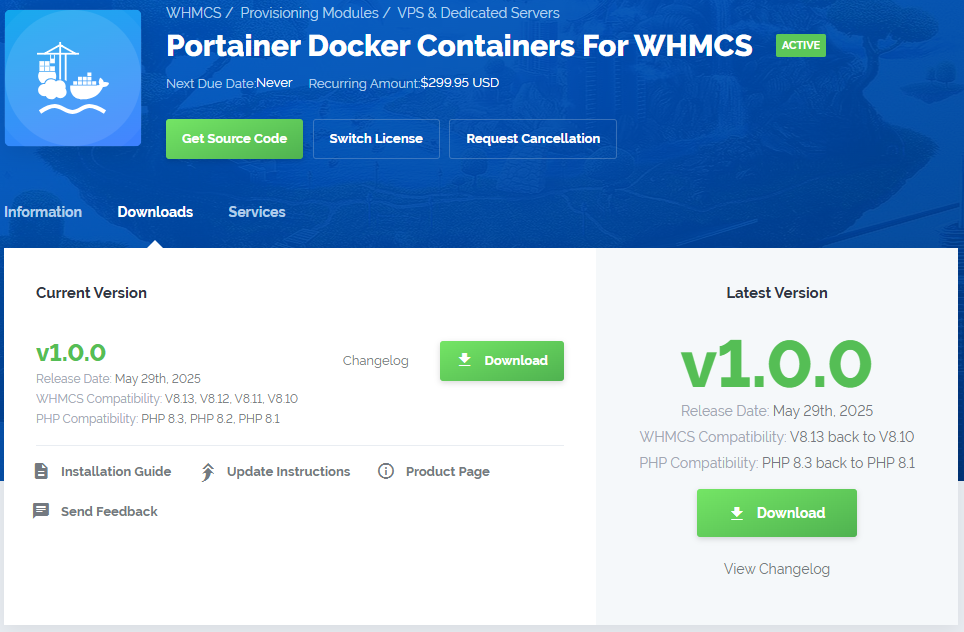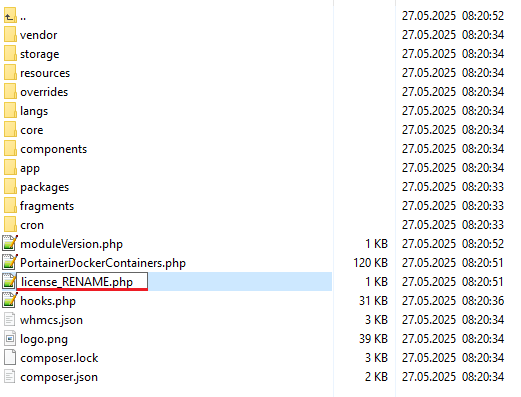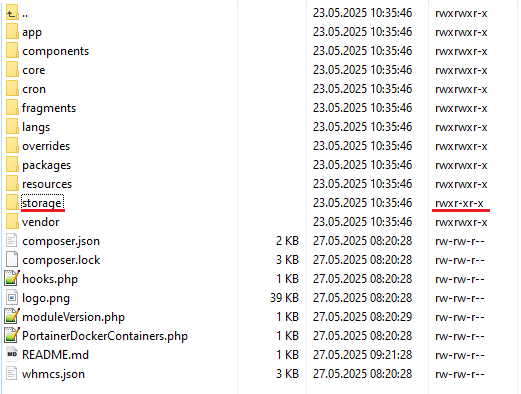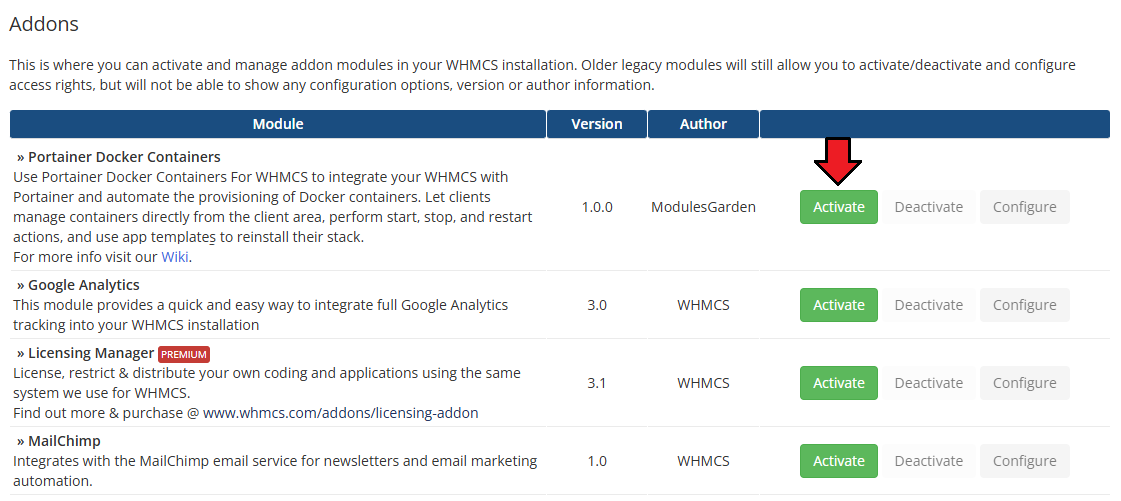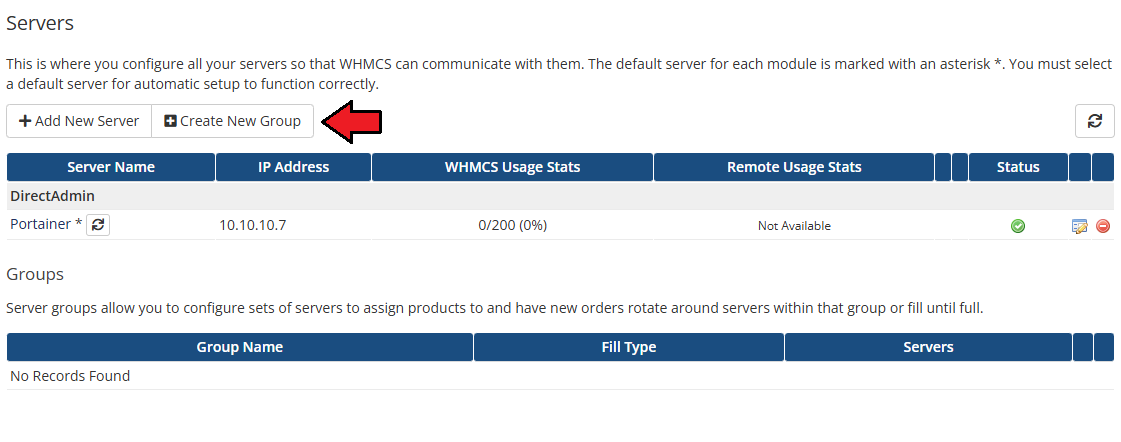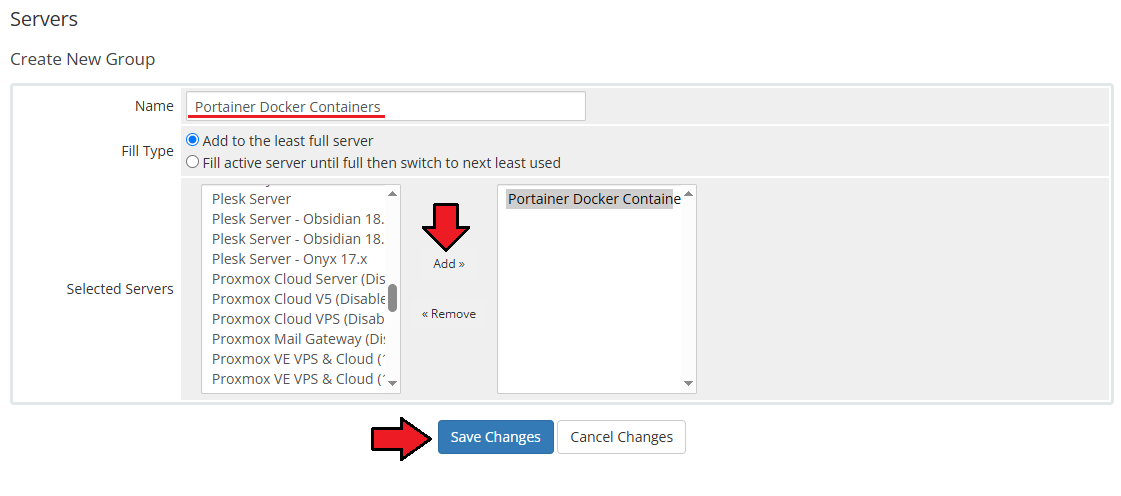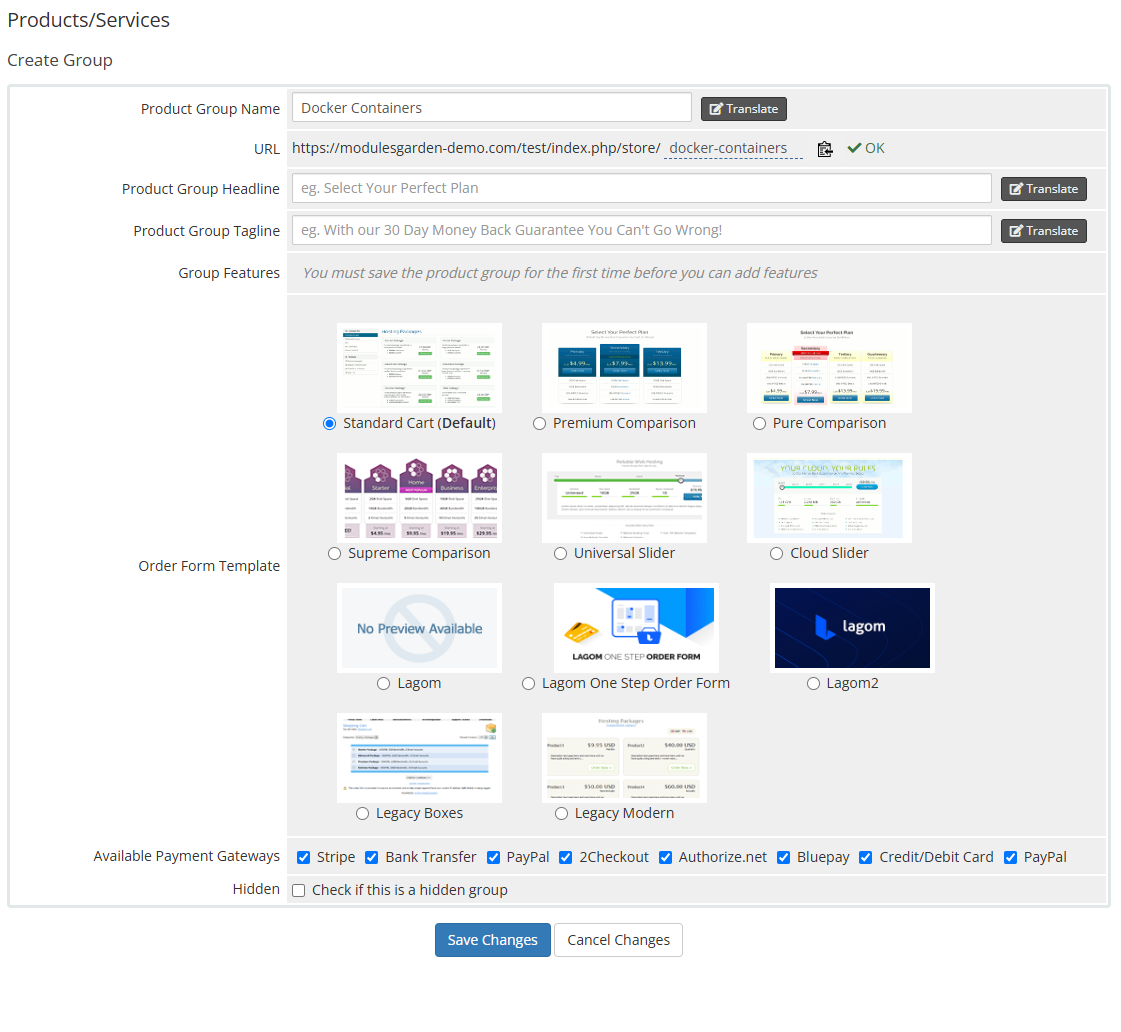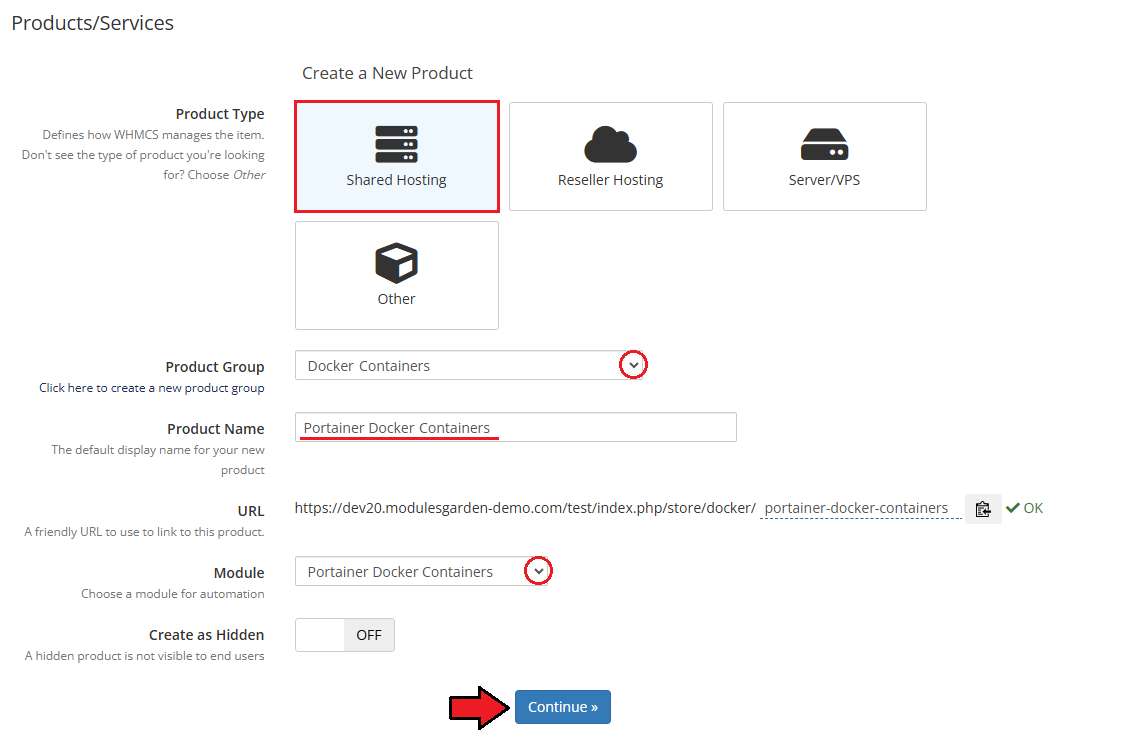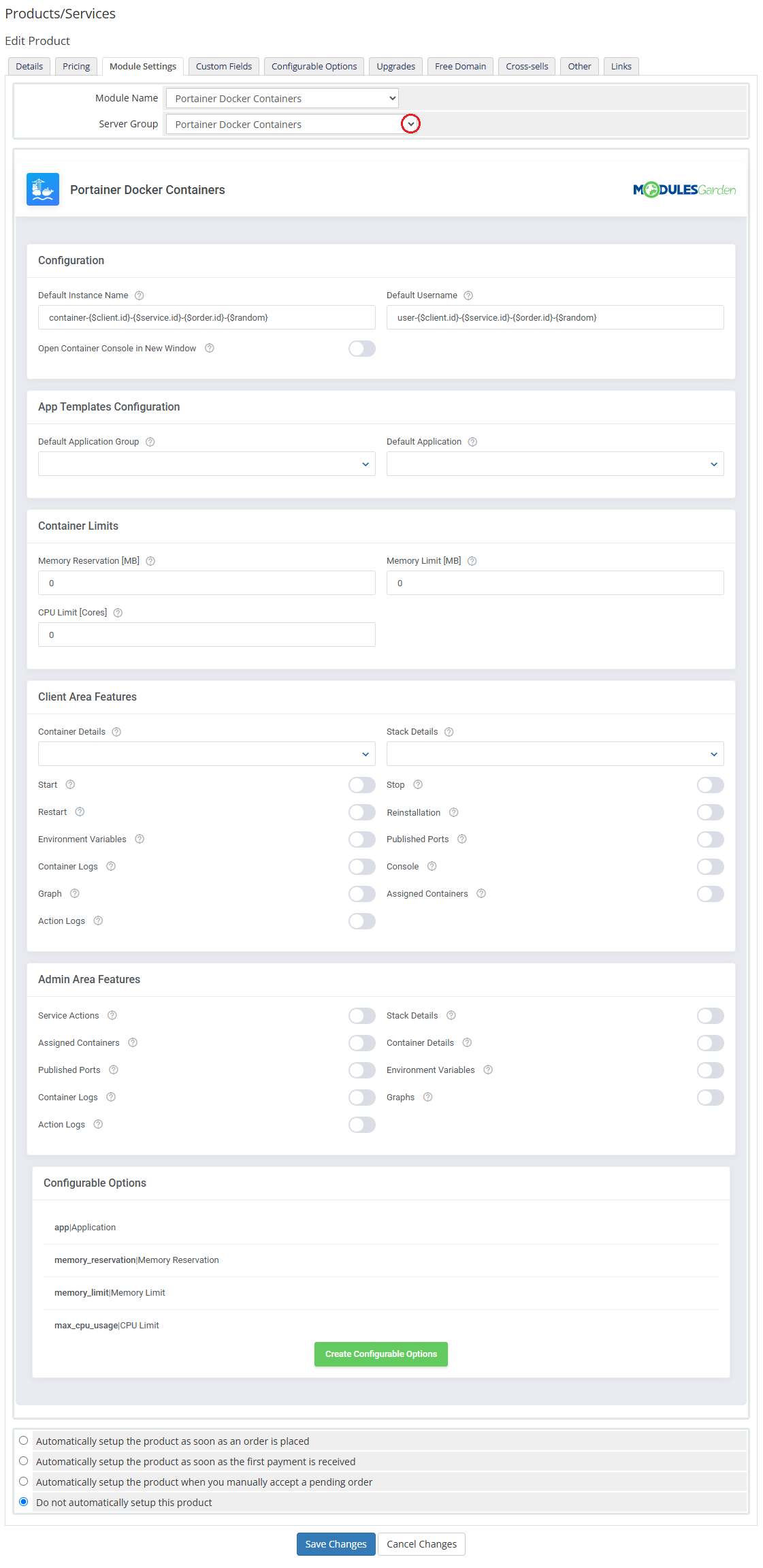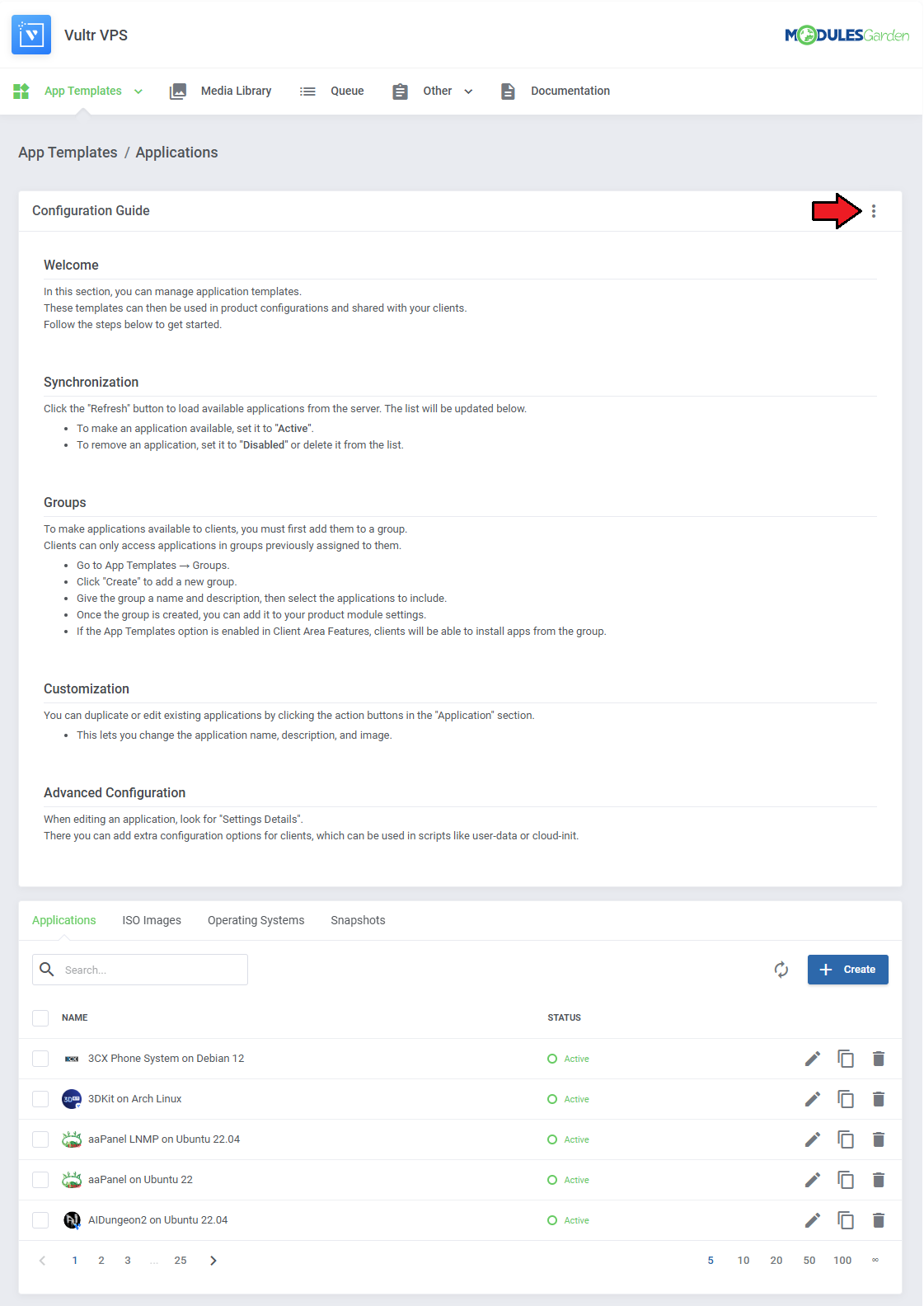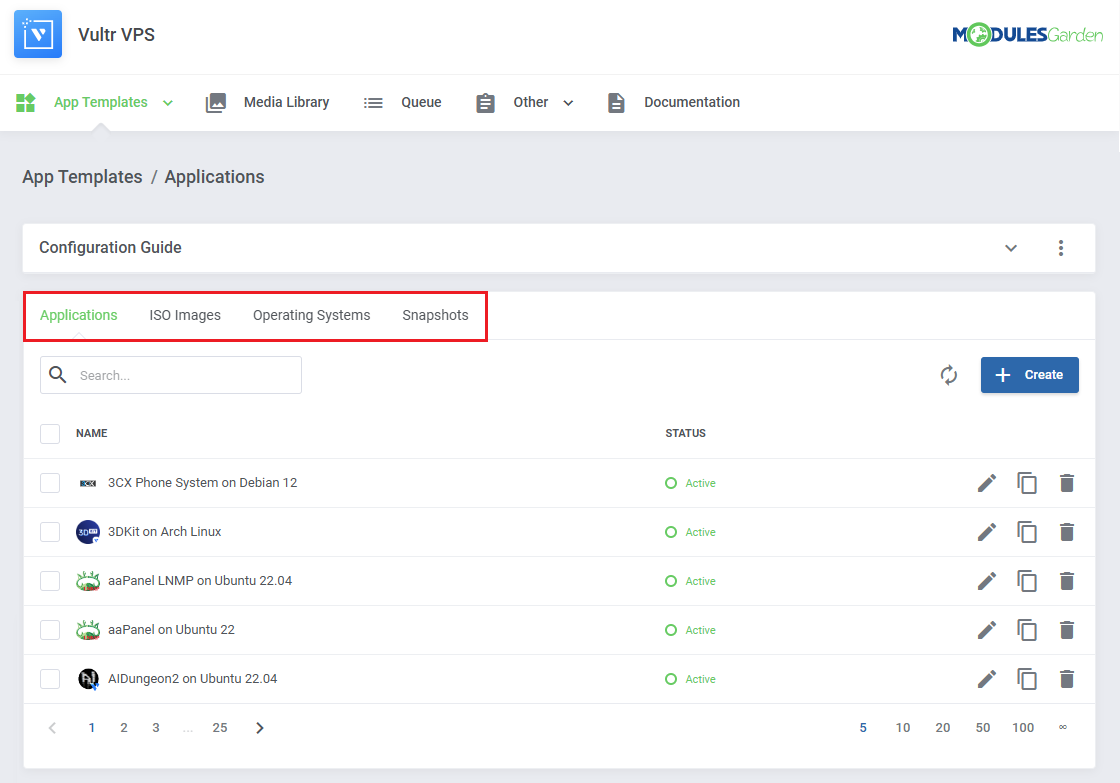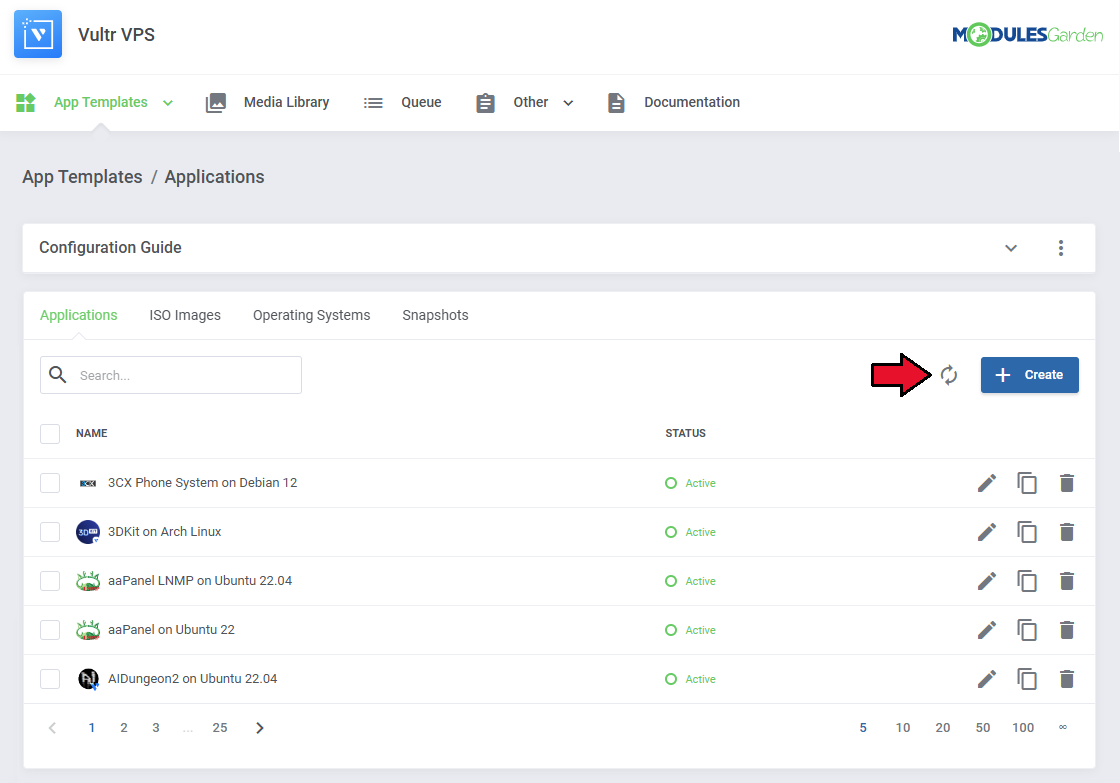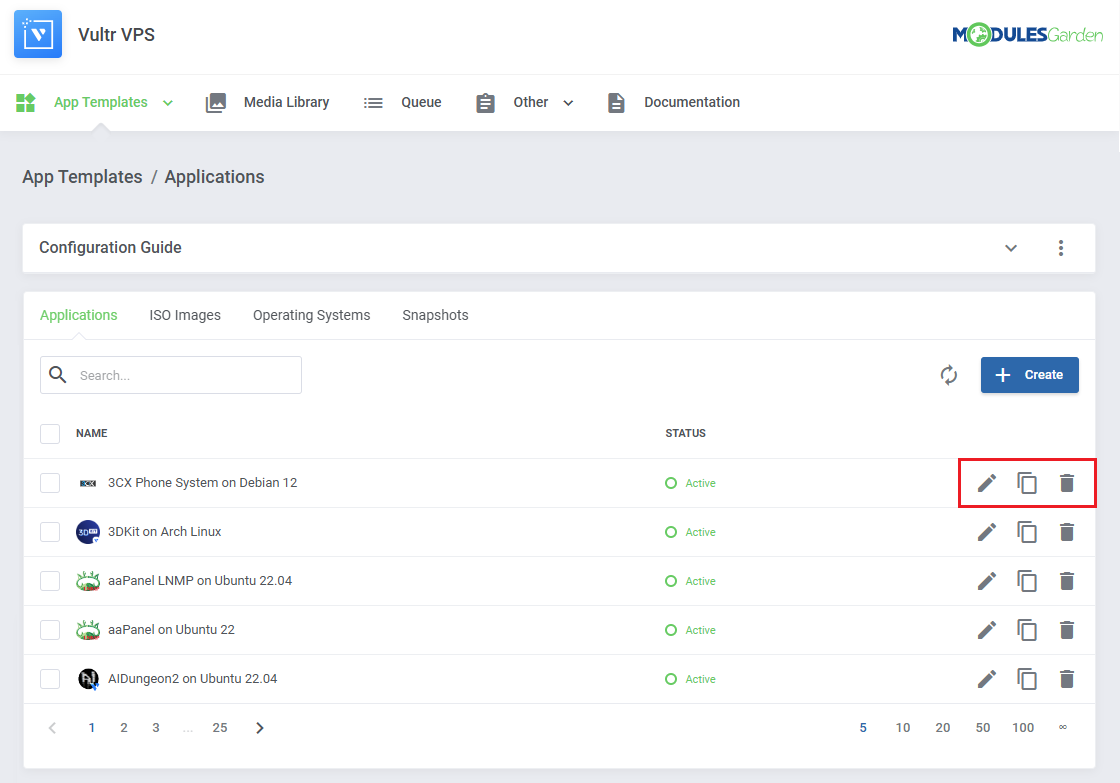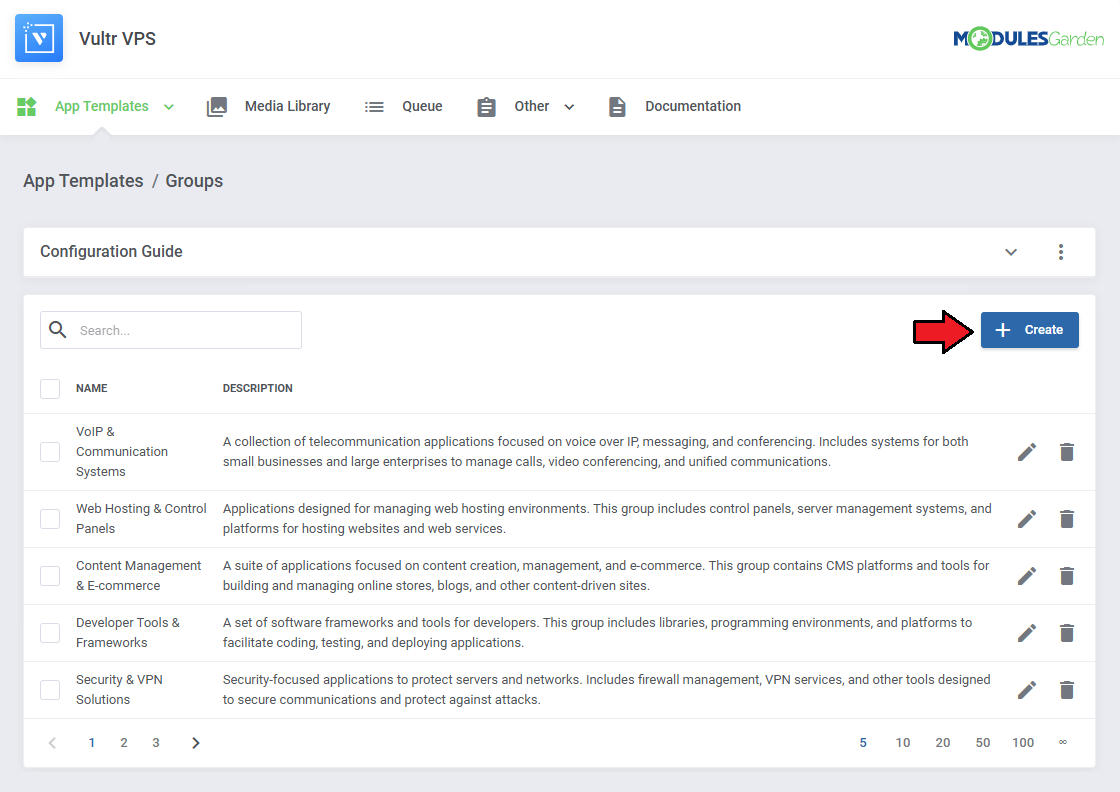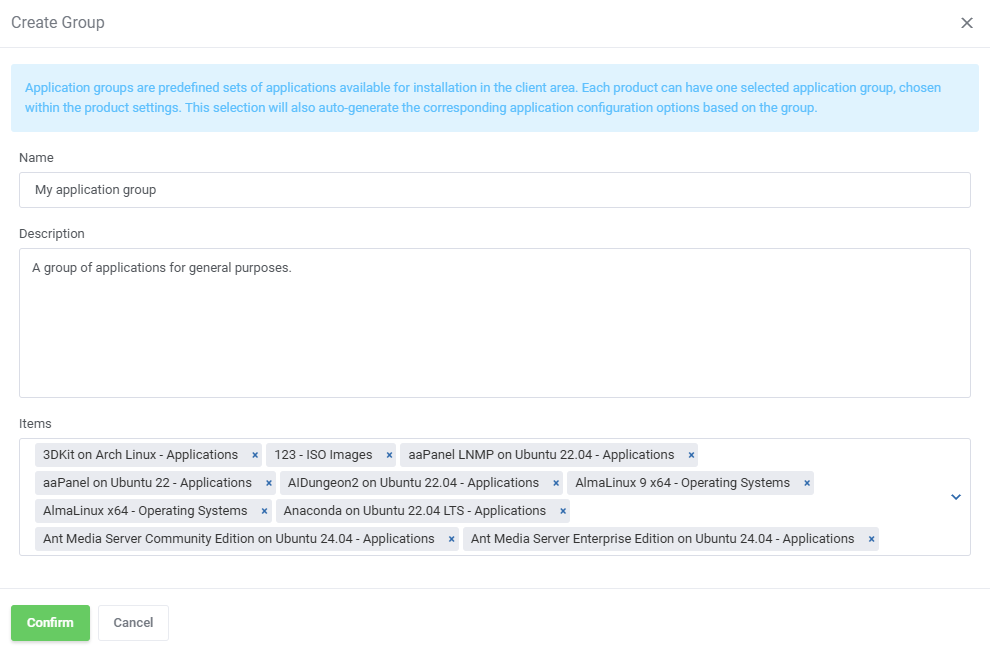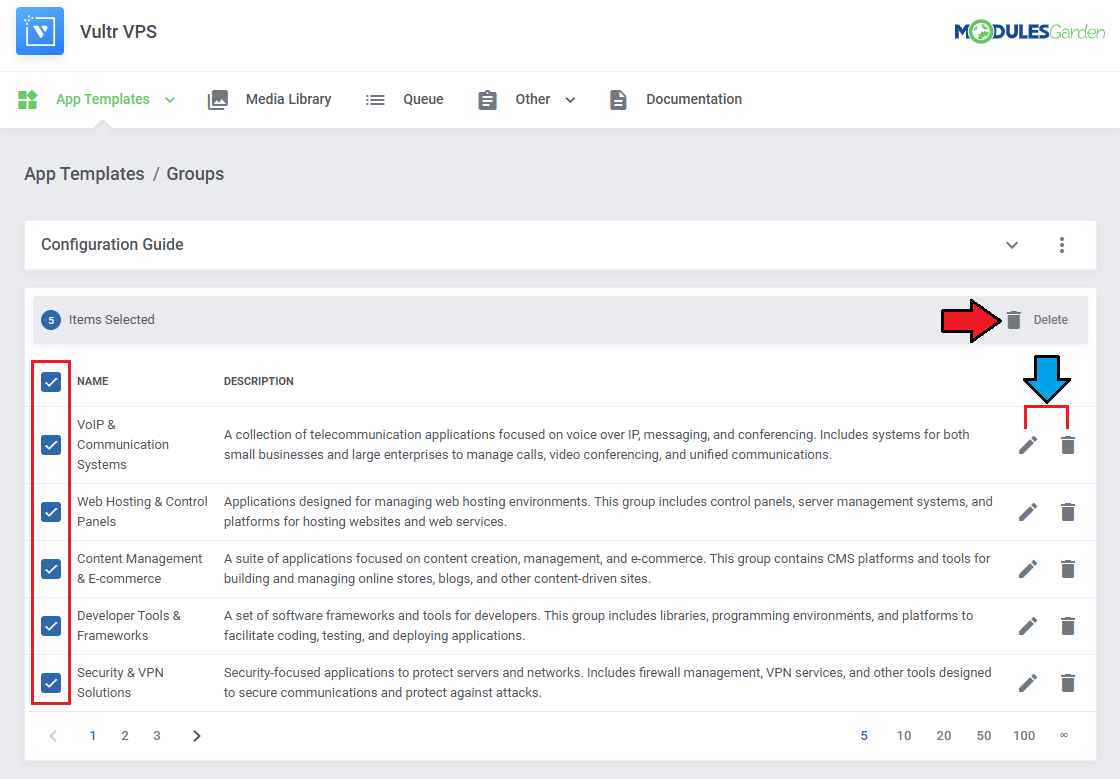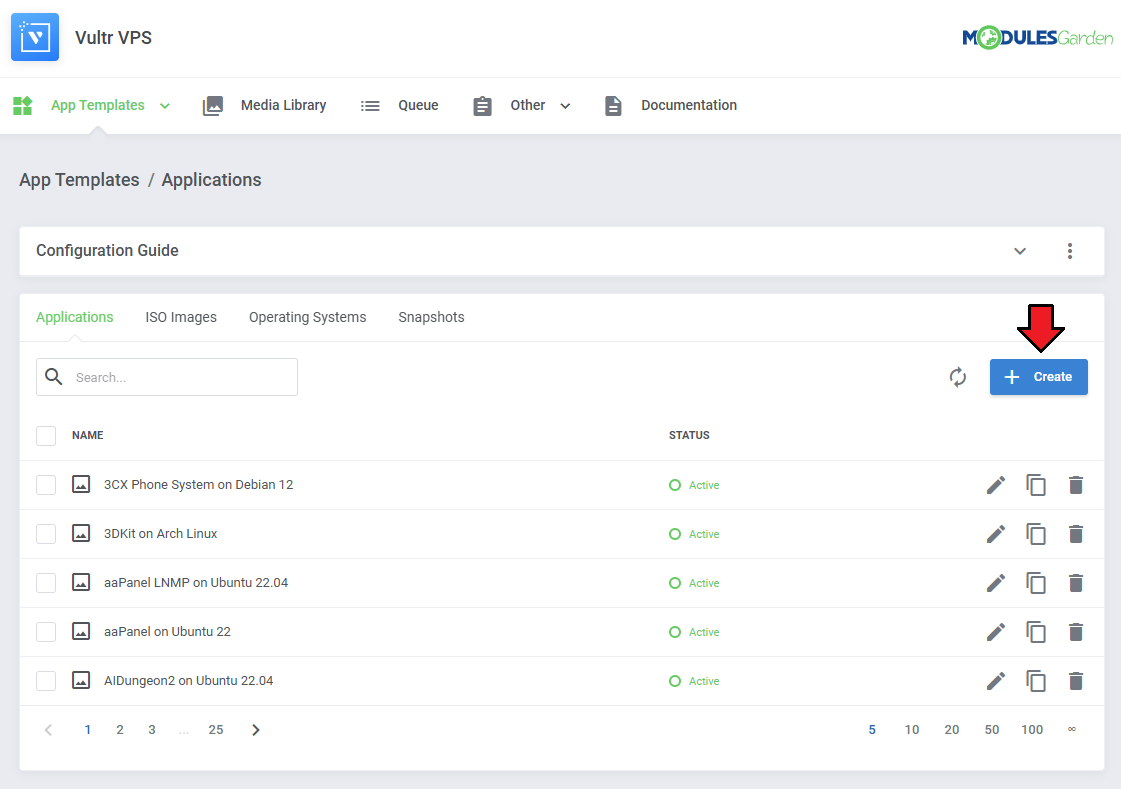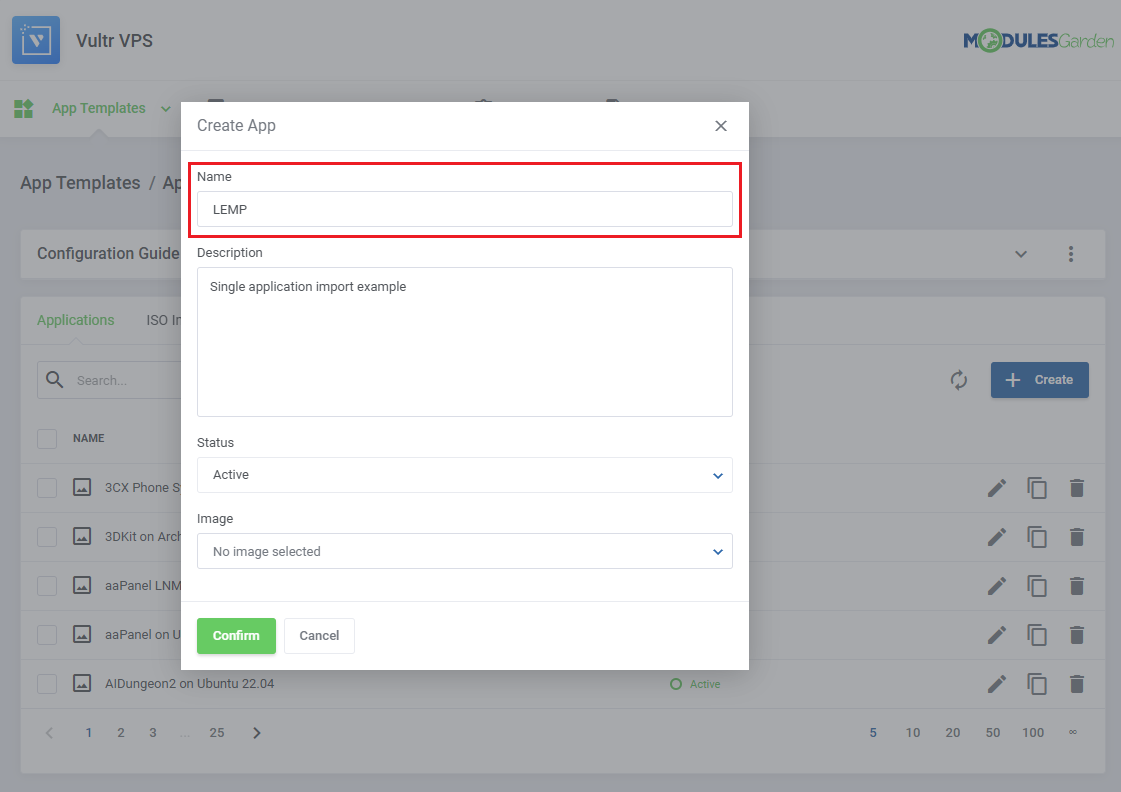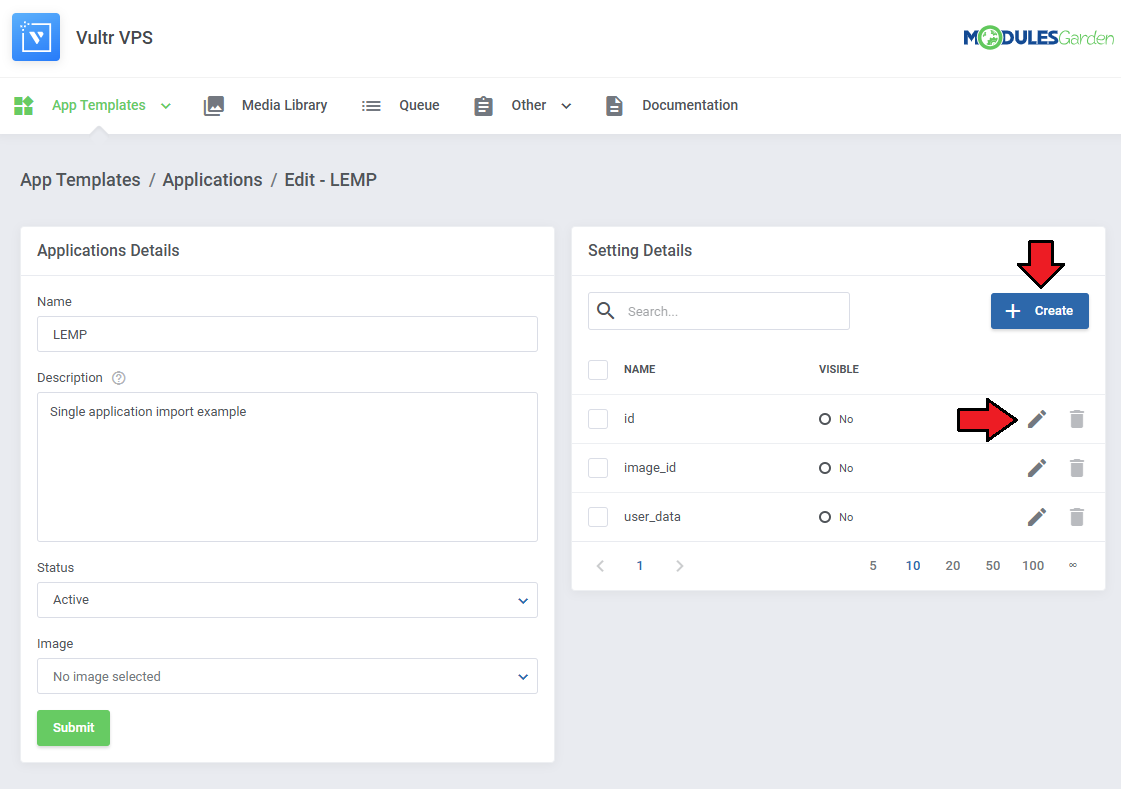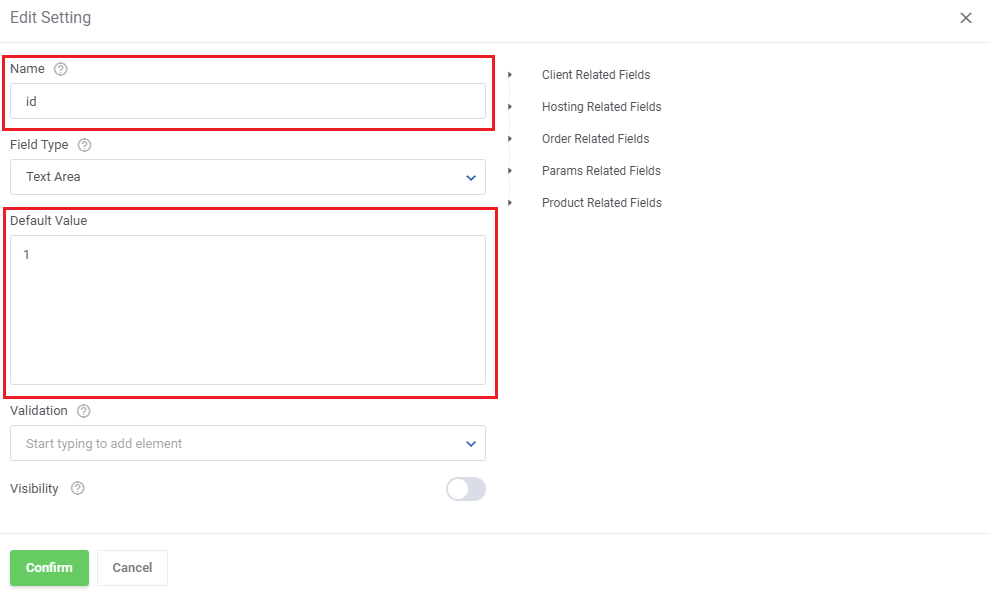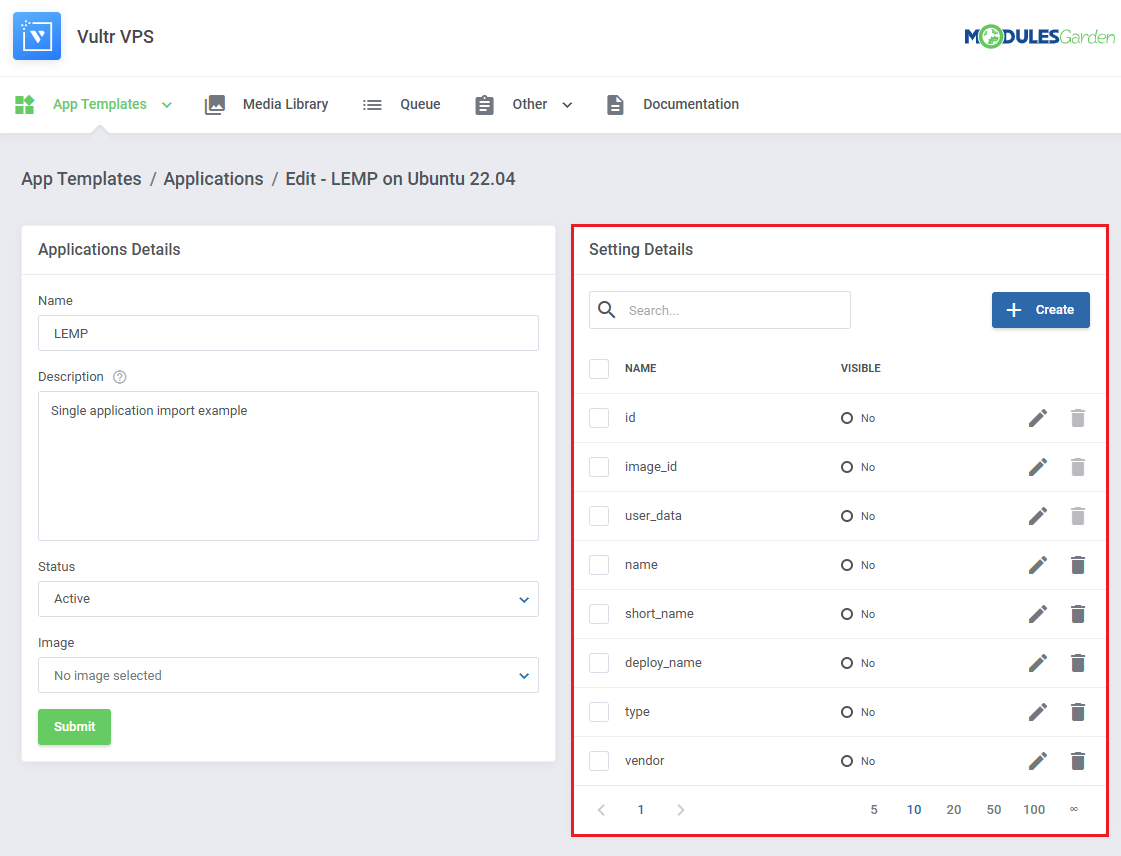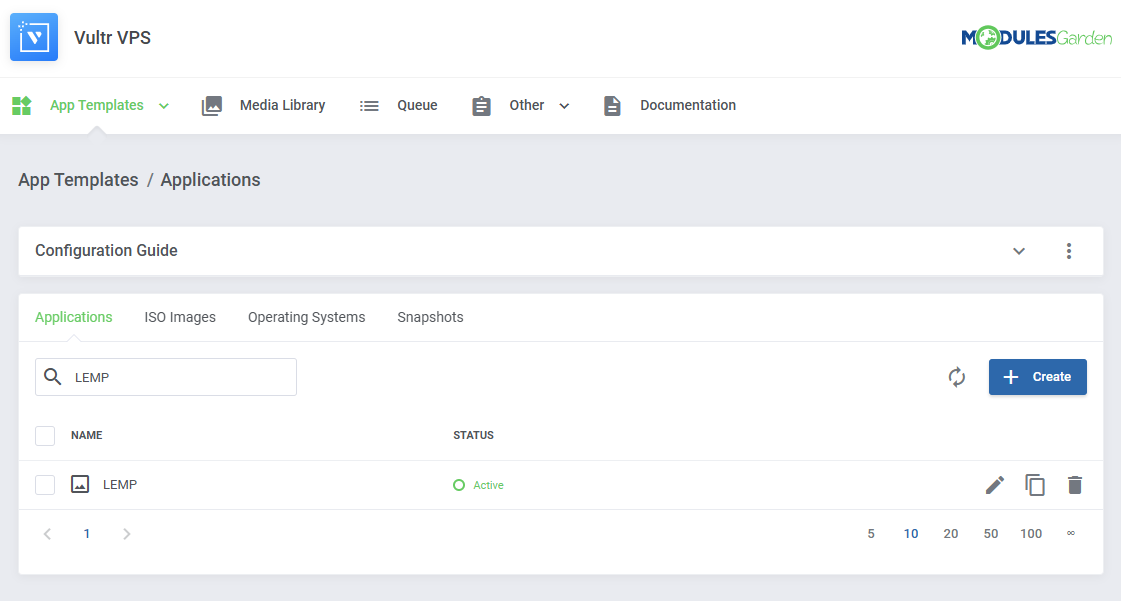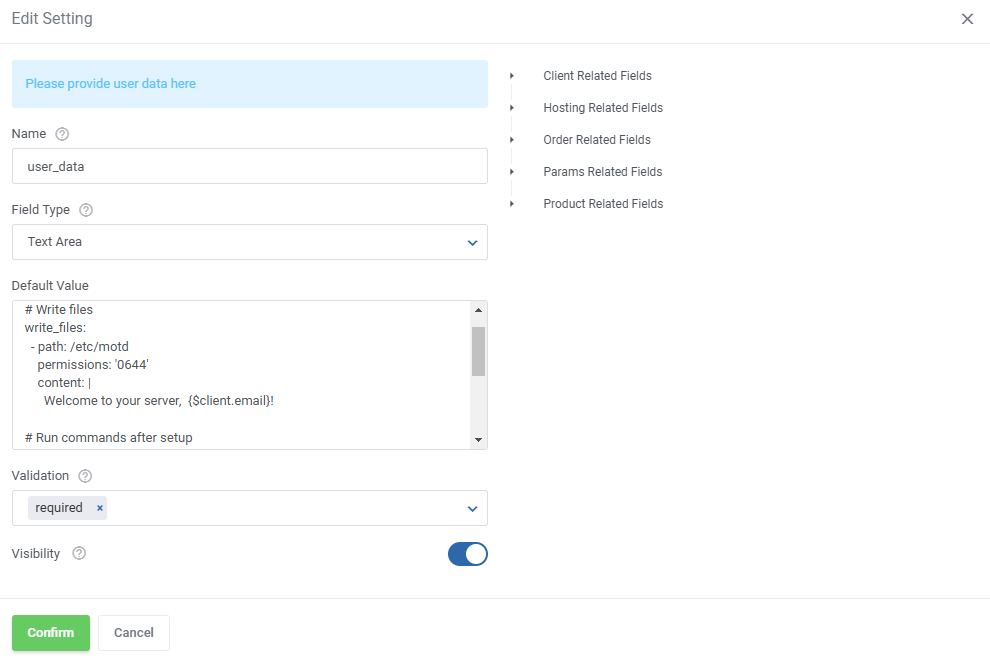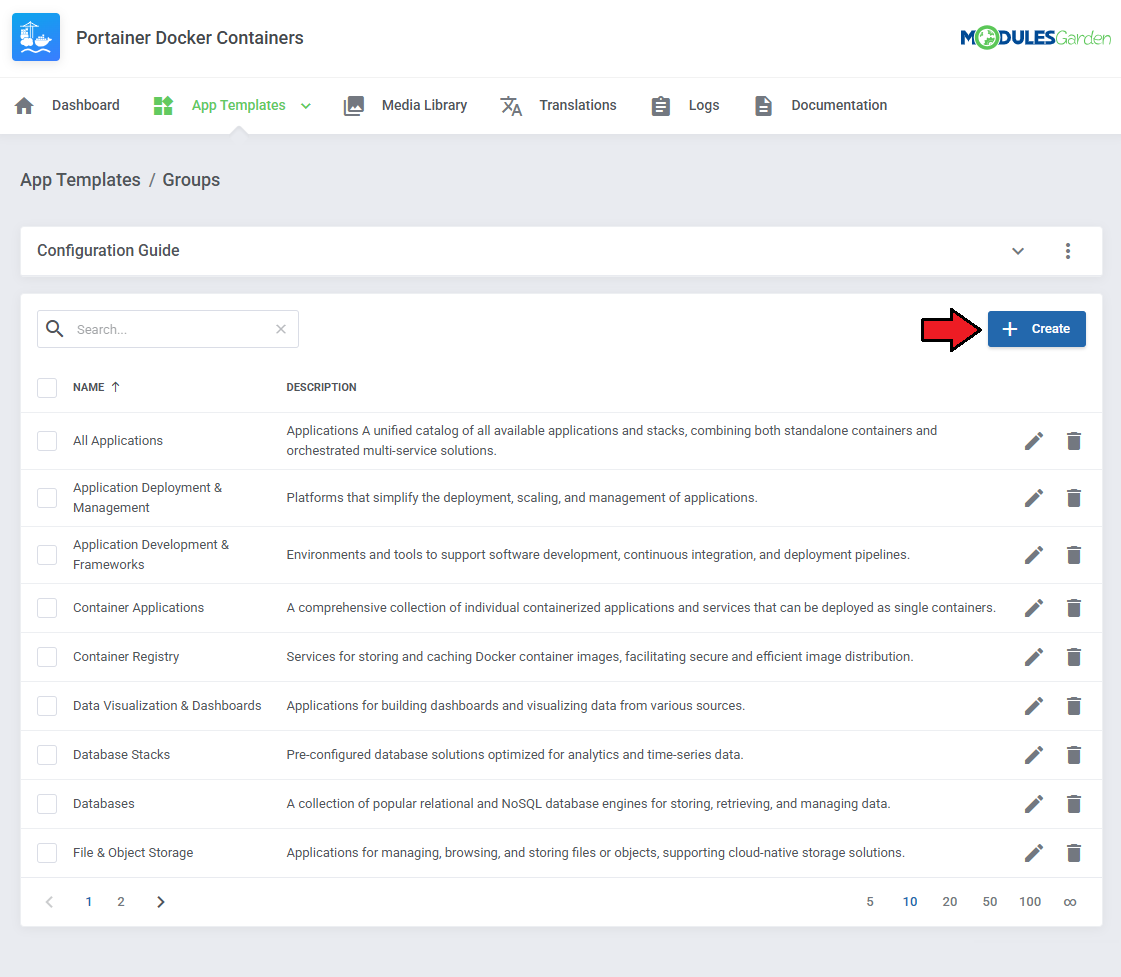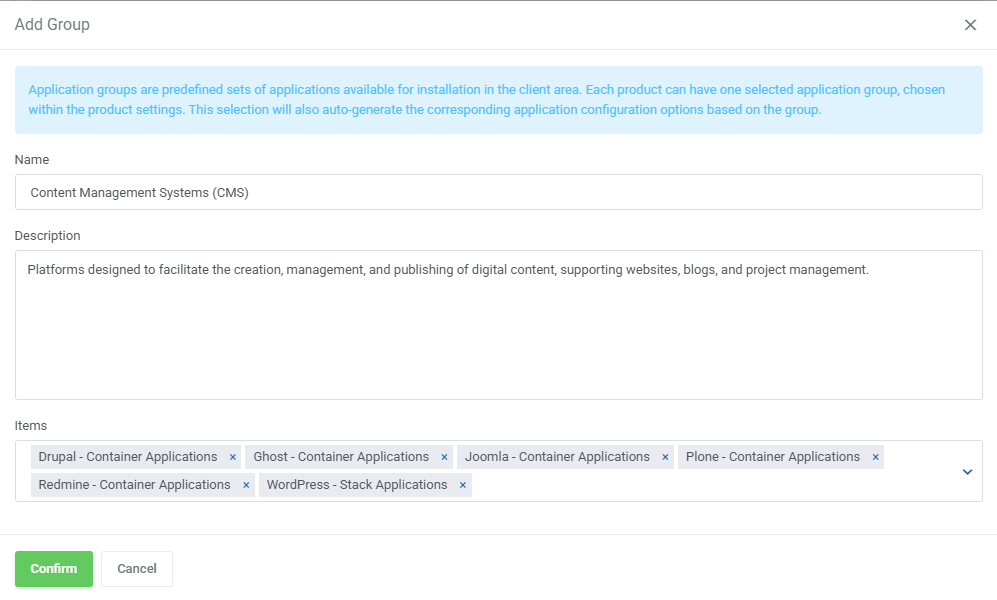Portainer Docker Containers For WHMCS
From ModulesGarden Wiki
(Difference between revisions)
|
|
| Line 235: |
Line 235: |
| | | | |
| | {| | | {| |
| − | |style="padding: 0px 0px 15px 15px;"|''25. Select the features that will be available in the admin area.'''<br/> | + | |style="padding: 0px 0px 15px 15px;"|'''25. Select the features that will be available in the admin area.'''<br/> |
| | These options define what information and controls admins will see within the WHMCS service management page:<br/> | | These options define what information and controls admins will see within the WHMCS service management page:<br/> |
| | | | |
| Line 265: |
Line 265: |
| | {| | | {| |
| | |style="padding: 0px 0px 20px 25px;"|[[File:PDC_18.png]] | | |style="padding: 0px 0px 20px 25px;"|[[File:PDC_18.png]] |
| − | |}
| |
| − | {|
| |
| − | |style="padding: 0px 0px 15px 15px;"|'''25. At the end of the configuration process, you can decide whether to generate configurable options for the product.'''<br/>
| |
| − | Configurable options allow clients to customize container parameters individually during the order process.
| |
| − | If no configurable options are defined, the fixed values set in the product configuration will be used instead.
| |
| − |
| |
| − | '''Available Configurable Options:'''
| |
| − | * <code>app</code> – '''Application'''
| |
| − | * <code>memory_reservation</code> – '''Memory Reservation'''
| |
| − | * <code>memory_limit</code> – '''Memory Limit'''
| |
| − | * <code>max_cpu_usage</code> – '''CPU Limit'''
| |
| − | |}
| |
| − | {|
| |
| − | |style="padding: 0px 0px 30px 25px;"|[[File:PDC_19.png]]
| |
| | |} | | |} |
| | | | |
Revision as of 11:32, 13 May 2025
Portainer Docker Containers For WHMCS is a module that connects your WHMCS system with Portainer, allowing you to sell and manage Docker containers just like traditional hosting products.
It automates the deployment process, so containers are created, configured, and assigned to clients instantly upon purchase.
Clients can control their containers directly from the WHMCS client area, including start, stop, restart actions, viewing logs, accessing the console, and more.
You can also enable "App Templates" to let clients reinstall their stack using predefined configurations.
|
| ✔ Set Failure Count To Trigger Notification
|
| ✔ Create Monitoring Checks For Allowed Services Within Specified Limits:
|
| ✔ Set Server Monitoring Check Limit
|
| ✔ Multi-Language Support With Custom Translations Tool
|
| ✔ Supports PHP 8.4 Back To PHP 8.1
|
| ✔ Supports WHMCS V8.13 Back To WHMCS V8.10
|
| ✔ Requires ionCube Loader V14 Or Later
|
Installation And Confiuration
This tutorial will show you how to successfully install and configure Portainer Docker Containers For WHMCS.
We will guide you step by step through the whole installation and configuration process.
|
| 1. Log in to our client area and download the module.
|
2. Extract the package and upload its content into the main WHMCS directory.
The content of the package to upload should look like this.
|
3. When you install Portainer Docker Containers For WHMCS for the first time you have to rename 'license_RENAME.php' file.
The file is located in 'modules/addons/PortainerDockerContainers/license_RENAME.php'. Rename it from 'license_RENAME.php' to 'license.php'.
|
4. In order to configure your license key, you have to edit the previously renamed 'license.php' file.
Enter your license key between quotation marks as presented on the following screen. You can find your license key in our client area → 'My Products'.
|
5. Now, set up the 'storage' folder as recursively writable.
This folder is available at '/yourWHMCS/modules/addons/PortainerDockerContainers/'.
|
Addon Activation
5. Now you have to activate the module in your WHMCS system.
Log in to your WHMCS admin area. Go to 'System Settings' → 'Addon Modules'. Afterwards, find 'Portainer Docker Containers' and press the 'Activate' button.
|
6. In the next step, you need to permit access to this module.
To do so, click on the 'Configure' button, tick 'Full Administrator' and press 'Save Changes'.
|
8. You have just successfully installed Portainer Docker Containers For WHMCS!
You can access your module under 'Addons' → 'Portainer Docker Containers'.
Read the guide provided on the 'Dashboard' or continue with this documentation.
|
Configuration of Server
| 12. Now, log in to your WHMCS and proceed to 'System Settings' → 'Servers' and press 'Add New Server'.
|
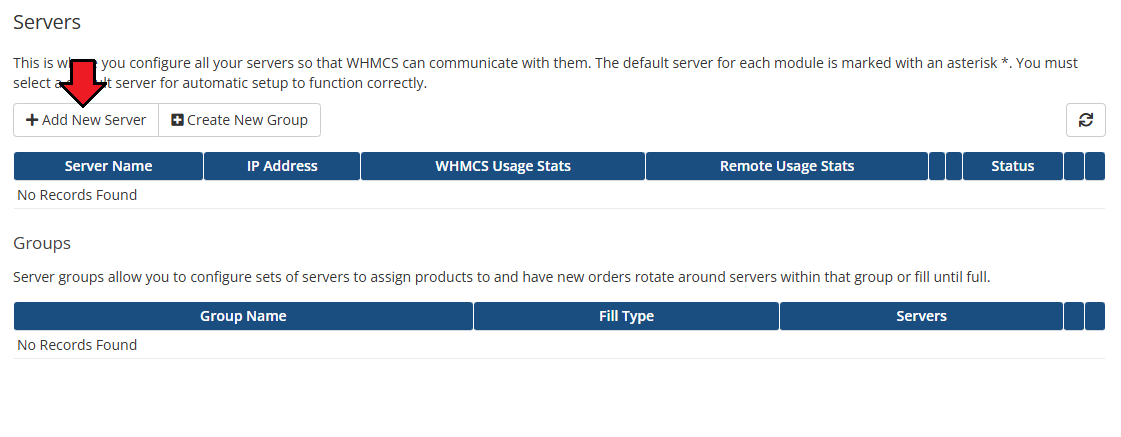
|
13. Fill in the Name, Hostname, and IP Address fields at the top (both Hostname and IP Address are required to proceed).
In the Server Details section:
- Set Module to 'Portainer Docker Containers'
- Enter your Portainer API key in the Password field (use an admin account token).
- Click Test Connection to ensure proper communication with the Portainer instance.
- Click the Configure button to select your desired environment (Portainer endpoint).
Note: The environment defines all core settings, such as available resources (CPU, RAM, GPU) and what container or stack templates will be used.
These are configured directly in Portainer. In the WHMCS module, you only choose from existing environments.
- After selecting the environment, the Access Hash will be filled in automatically.
- If your Portainer server uses SSL, ensure the Secure' checkbox is enabled.
You can also enable the Override with Custom Port option and enter your custom Portainer API port.
- Finally, adjust SSO Access Control if needed, then click Save Changes.
|
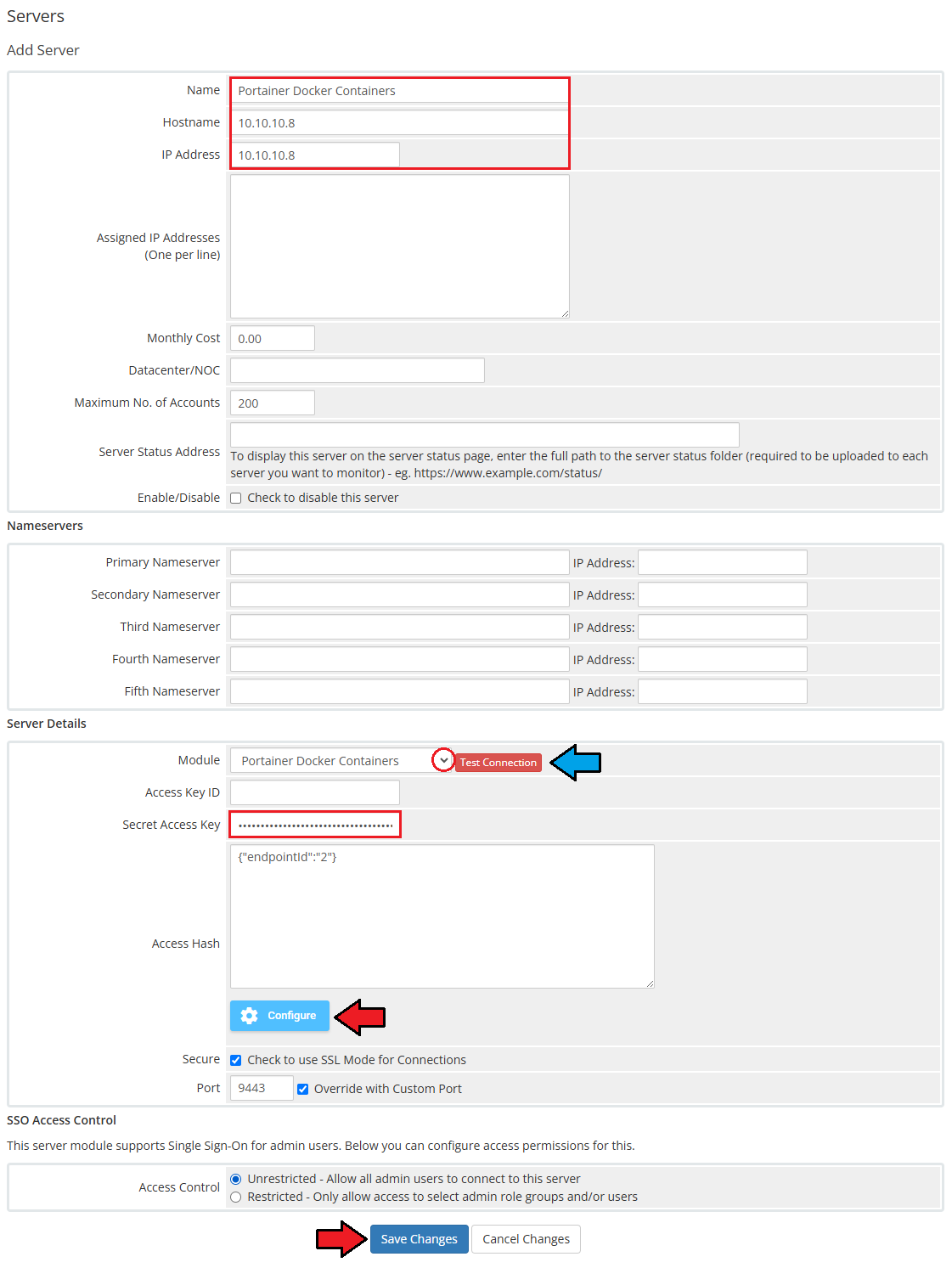
|
| 14. It is time to create a server group. To do so, click on 'Create Server Group'.
|
| 15. Enter a name, click on your previously created server, press 'Add' and afterward 'Save Changes'.
|
Configuration of Product
16. In order to create and configure a product, go to 'System Settings' → 'Products/Services'.
Click on 'Create a New Group' .
|
| 17. Enter a product group name and press 'Save Changes'.
|
18. When you have a product group, you can create your product.
To create a product click on 'Create a New Product' .
|
19. Afterward, choose your product group, module and type from the dropdown menus, enter your product name and press 'Continue'.
'Product Type' should be set to 'Shared Hosting'.
|
20. Now, go to the 'Module Settings' section, choose your previously created server group from the dropdown menu.
The module should automatically save and reload settings. If not, click on 'Save Changes' manually.
|
21. Proceed to Configuration.
- Default Instance Name – Enter the default name to be used when creating a new stack or container. The name must contain only lowercase letters, digits, hyphens (-), or underscores (_).
Available variables: {$domain}, {$client.id}, {$service.id}, {$order.id}, {$random}.
If left empty, the domain name will be used.
- Default Username – Enter the default username to be used when creating a new user.
Available variables: {$domain}, {$client.id}, {$service.id}, {$order.id}, {$random}.
If left empty, the domain name will be used.
- Open Container Console in New Window – Enable this option to open the container console in a new window when the feature is available in the client area.
|
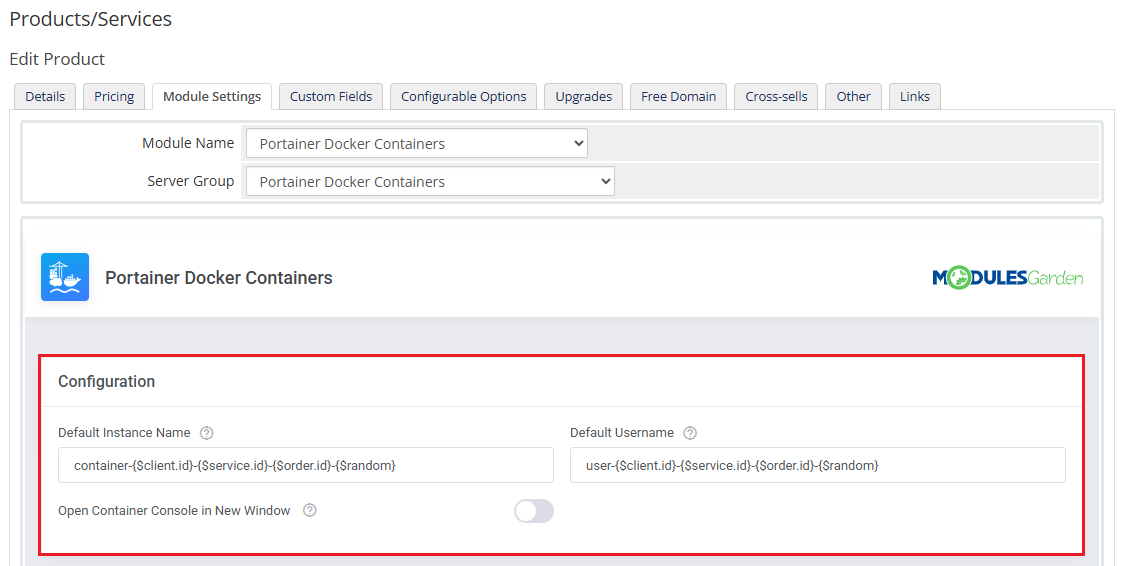
|
| 22. Proceed with 'App Template Configuration'.
App Templates Configuration - To create instances based on stack or container applications, you must first configure the App Templates in the module's addon.
Once your applications and groups are set up there, you can select the desired application in the product's Module Settings tab to be used during instance creation.
Please refer to the App Templates section of the documentation for detailed setup instructions.
- Default Application Group - group of applications allowed for reinstalls, see the groups section.
- Default Application - default application to be installed on the VPS, see the applications section.
|
23. Set up container limits:
- Memory Reservation [MB] - Specify the amount of memory (in MB) reserved for the container. Set to 0 for no reservation.
- Memory Limit [MB] - Set the maximum amount of memory (in MB) the container can use. Use 0 for unlimited.
- CPU Limit [Cores] - Set the maximum number of CPU cores available to the container. Use 0 for unlimited.
Alternatively, you can use configurable options to allow clients to define these limits at checkout.
|

|
24. Next, select the features that will be available in the client area.
- Container Details – Show basic information about the container, such as status, IP address, and resource usage.
- Stack Details – Display information related to the assigned stack configuration.
- Start – Allow clients to start their container.
- Stop – Allow clients to stop their container.
- Restart – Allow clients to restart their container.
- App Templates – Enable access to predefined application templates for quick reinstall.
- Environment Variables – Allow clients to view or manage container environment variables.
- Published Ports – Show mapped ports between the host and the container.
- Container Logs – Provide access to real-time container logs.
- Console – Allow access to the container's interactive console.
- Graph – Show performance graphs such as CPU, memory, and network usage.
- Assigned Containers – Display a list of all containers assigned to the client.
- Action Logs – Provide a history of actions performed on the container (e.g. start, stop, reinstall).
|

|
25. Select the features that will be available in the admin area.
These options define what information and controls admins will see within the WHMCS service management page:
- Service Actions – Perform start, stop, or restart actions directly from the admin area.
- Stack Details – View the full configuration and status of the assigned stack.
- Assigned Containers – Display all containers linked to the service.
- Container Details – Show detailed information about the container, such as IP address, image, and resource usage.
- Published Ports – View the port mappings for the container.
- Environment Variables – View environment variables set for the container.
- Container Logs – Access logs generated by the container.
- Graphs – Display real-time resource usage graphs (CPU, RAM, network, disk I/O).
- Action Logs – Review all actions performed on the container or stack from within WHMCS.
|
25. At the end of the configuration process, you can decide whether to generate configurable options for the product.
Configurable options allow clients to customize container parameters individually during the order process.
If no configurable options are defined, the fixed values set in the product configuration will be used instead.
Available Configurable Options:
-
app – Application
-
memory_reservation – Memory Reservation
-
memory_limit – Memory Limit
-
max_cpu_usage – CPU Limit
|
Management
Server Monitoring For WHMCS empowers your clients with tools to monitor their services directly from the WHMCS client area.
In this brief guide, we will introduce the module’s capabilities and show you how to make the most of its features.
|
Module Addon
| The module addon is where all of the setup and management take place for the admin.
It allows you to add products to the module, enabling the creation of checks for services associated with those products.
It also features several management tools like the queue, translations tool and module logs.
|
App Templates
'App Templates' allow you to manage and ultimately provide applications, ISO images, operating systems, and snapshots to your clients.
Prepare templates in the 'Applications' tab and gather them into groups in the 'Groups' tab.
For clients to be able to install templates on their VPS, their product has to include an 'Application Group' and allow 'App Templates' in the client area.
|
Applications
Read the guide carefully, as it contains crucial information on how to use 'App Templates'.
You can change the settings and have the guide collapsed by default. Clicking on the 'Additional Actions' button, select 'Options' and 'Collapse Guide'.
|
| You can switch between Applications, ISO Images, Operating Systems, and Snapshots by clicking on relevant tabs.
|
| You can use the refresh button to download and later refresh templates from the server.
|
Once the items are loaded, you can use the action buttons to edit, duplicate or delete them from the list.
You can also use the mass action buttons to manage multiple templates at once.
|
Groups
With the templates ready, all that is left is to gather them into groups and include said groups into products.
Navigate to 'App Templates' → 'Groups' and click on the 'Create' button.
|
Read the information, then provide the group with:
- Name
- Description
- Items to include
Note: Keep in mind that Vultr includes Windows licenses (Core and Standard) in their Plans and charges a monthly fee for them.
Since this will affect the Plan price, we recommend not including Windows with other systems in one product.
|
| You can use the action button and the mass action function to edit and delete groups.
|
For the client to take advantage of the application templates, the product module settings have to include the group.
Find the 'App Templates Configuration' section and 'Default Application Group' field.
Include a chosen group for the product.
|
| Make sure 'App Templates' section is enabled under 'Client Area Features'.
|
Advanced Configuration
| App templates allow for even more in-depth management with the ability to create and edit custom applications.
See the examples below to learn about the most important options.
|
Adding Applications Manually
Manually add a single application, instead of loading all your applications at once.
1. Navigate to 'App Templates' → 'Applications' and click on 'Create'.
|
| 2. Download the list of applications from you panel's API.
See the official official Vultr documentation too learn how.
Make sure to include your API Key, the request looks like this:
curl "https://api.vultr.com/v2/applications" \
-X GET \
-H "Authorization: Bearer ${VULTR_API_KEY}"
Example result:
{
"applications": [
{
"id": 1,
"name": "LEMP",
"short_name": "lemp",
"deploy_name": "LEMP on CentOS 6 x64",
"type": "one-click",
"vendor": "vultr",
"image_id": ""
}
|
| 3. In the 'Name' field we recommend including the value of the '"name": "$name"' field.
For example 'LEMP' from:
"name": "LEMP",
Note: If you include a 'name' setting detail (see step 4) with the name from the request as its value, you can safely rename the application to something else here.
|
| 4. Edit your newly added application, and under 'Settings Details' edit/create application details outputted by the panel's API.
|
| Carefully look at the API output and fill out the 'Name' and 'Default Value' fields with you application details.
In our case it is:
"id": 1,
|
| Add the remaining settings following the same pattern of filling the 'Name' and 'Default Value' fields.
|
| The application will be available on the list and ready to be included in a group.
|
Including Cloud-Init / User-Data Scripts
Enter the user data to run common configuration tasks when the instance starts. You can run cloud-init directives or shell scripts for Linux images. You may use smarty variables, e.g. {$password}.
Note: Please refer to the following article to find a list of supported module parameters and their descriptions.
If an application supports scripts, the responsible setting will always be added automatically.
To include a script, edit the setting by clicking on the 'Edit' button next to it.
|
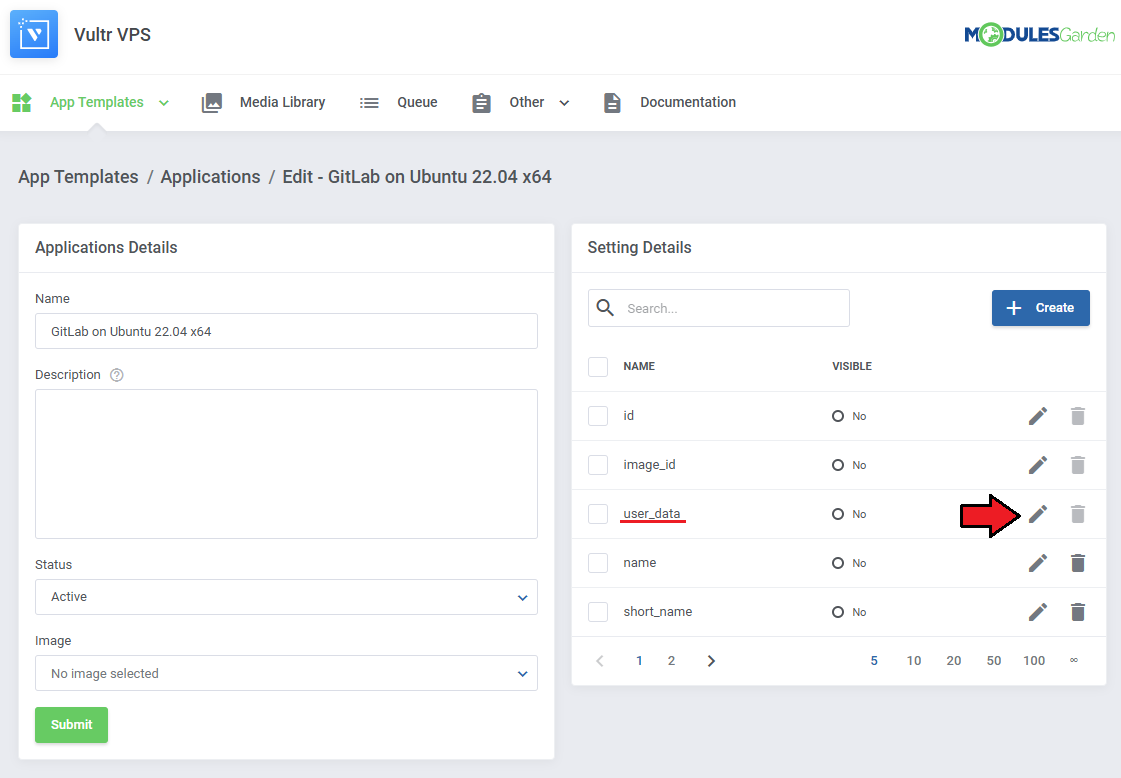
|
See the list below to learn how to set up the setting.
- Name - do not change this value, this is the setting identifier.
- Field Type - if the 'Visibility' setting is toggled on, this field decides the type of field, we recommend leaving it as is.
- Default Value - this is where you include your script. If 'Visibility' is toggled on, this will be the default value that clients can modify.
Note: Use the merge field list on the right for reference.
- Validation - optionally, provide Laravel validation rules like 'required'.
- Visibility - this will allow the client to modify the script before installation.
|
| If the 'Visibility' toggle is on, the script will be accessible before the installation, if not, the script will just be performed as normal.
|
Media Library
The media library allows you to upload images for use elsewhere in the module by admins and clients.
To upload a new picture, click on the 'Upload Image' button.
|
You can delete images one by one by clicking on them.
To delete all images at once, use the additional action button.
|
Customizing language files is now extremely easy with the "Translations" tool that is now available directly in the addon.
Its user-friendly design makes managing various language file tweaks a smooth and efficient process.
Prepare translations for the original English files with this handy built-in tool. For specific instructions on how to use this tool please refer to its dedicated article, you will find it here.
|
The 'Logs' section under the 'Other' tab is where the module logs are stored.
You can filter the module logs by type with the 'Show' buttons:
- Critical
- Error
- Notice
- All (Total)
All information on Logs can be found in the dedicated to logs article, you will find it here: https://www.docs.modulesgarden.com/Logs.
|
Dashboard
| The 'Dashboard' provides information and statistics related to the functions of the module.
At the top, you will find a condensed setup guide, presenting the same information as this documentation.
|
| After familiarizing yourself with the guide, you can opt to hide it under 'Additional Actions' → 'Settings'.
|
Client Area
Clients will be able to ........ with Portainer Docker Containers For WHMCS .......
The basic client area integration allows them to create and .....
|
Service Actions: Start Stop & Restart
|
Action Logs
| The 'Action Logs' allows you to..........
|
App Templates
The 'App Templates' allows you to easily install applications, ISO images, operating systems and snapshots on your VPS.
Important: Installations will wipe all existing data from the machine.
|
Tips
Update Instructions
An essential guidance through the process of updating the module is offered here.
Ensure successful completion of the module update by carefully following each step, thereby preventing data loss or any unforeseen issues.
Additionally, you will find a current list of supplementary actions necessary for a smooth update process there.
|
Upgrade Guide
Seeking a solution that offers greater flexibility, customization tailored to your precise needs, and unrestricted availability?
There is an option that not only proves to be cost-effective in the long run but also includes prioritized support services, making it a truly valuable investment.
Opt for the Open Source version of your Server Monitoring For WHMCS module to unlock these benefits.
Simply click on either the Get Source Code or Upgrade To Lifetime button found on the product's page in our client area to complete the one-step upgrade process, with a dedicated discount already applied.
Follow a comprehensive guide covering the transition process, the advantages it brings, and step-by-step instructions on what to do next after the order has been successfully finalized.
|
Common Problems
| 1. When you have problems with connection, check whether your SELinux or firewall does not block ports.
|
